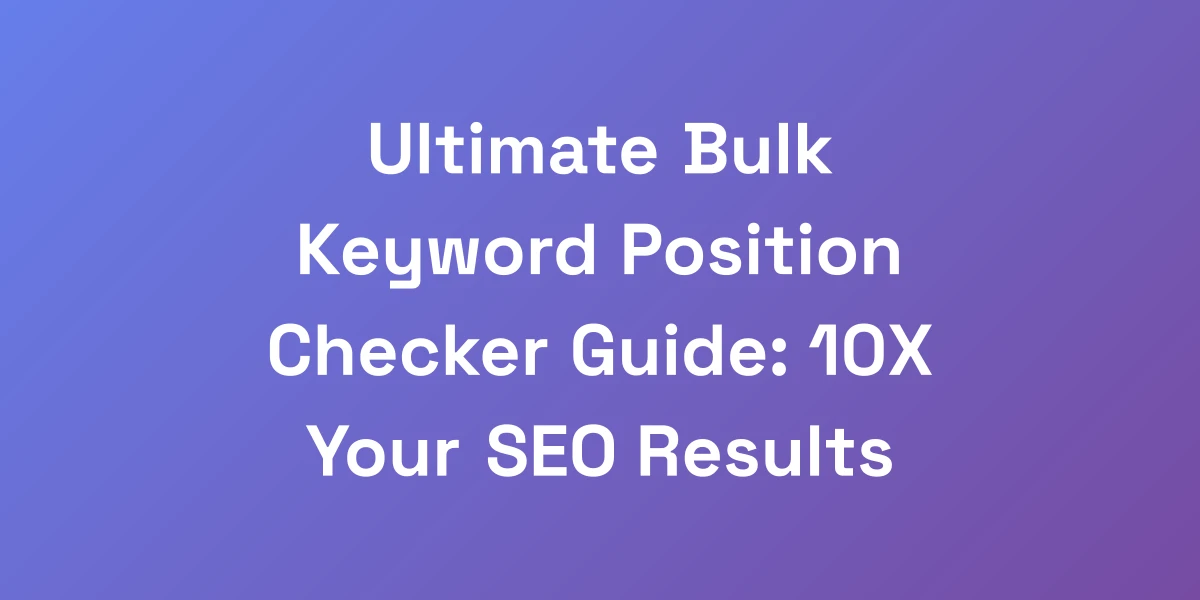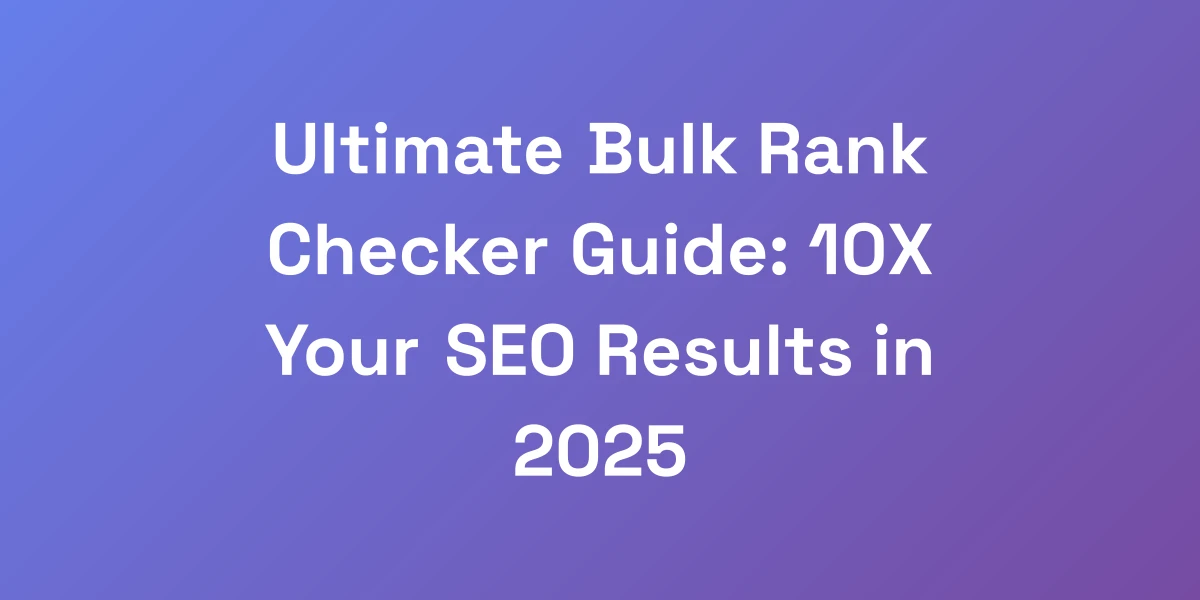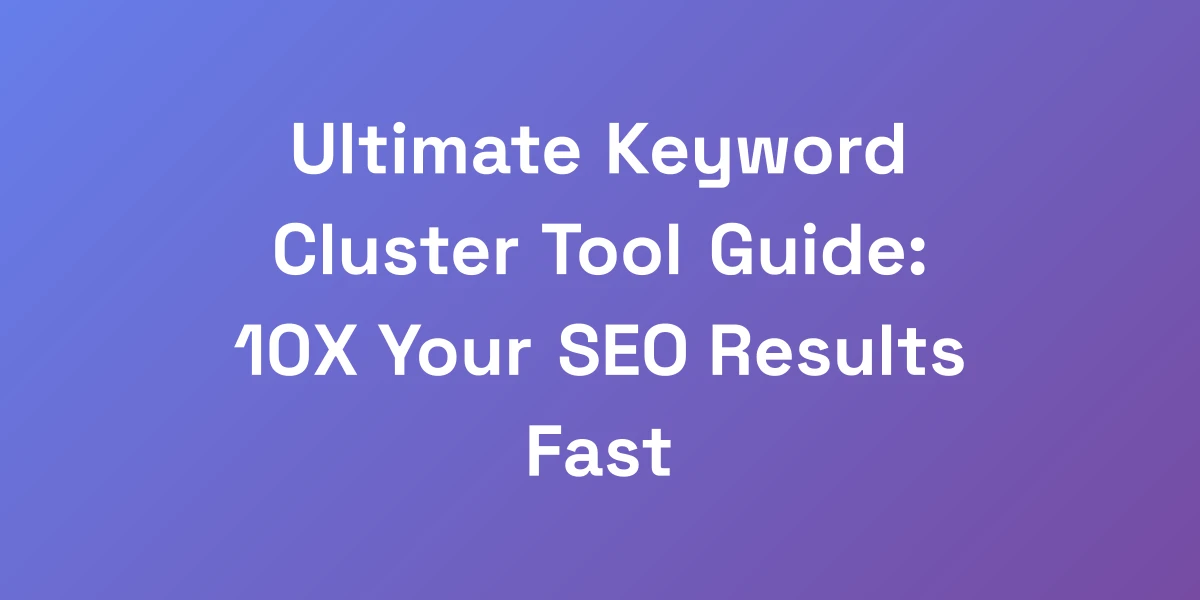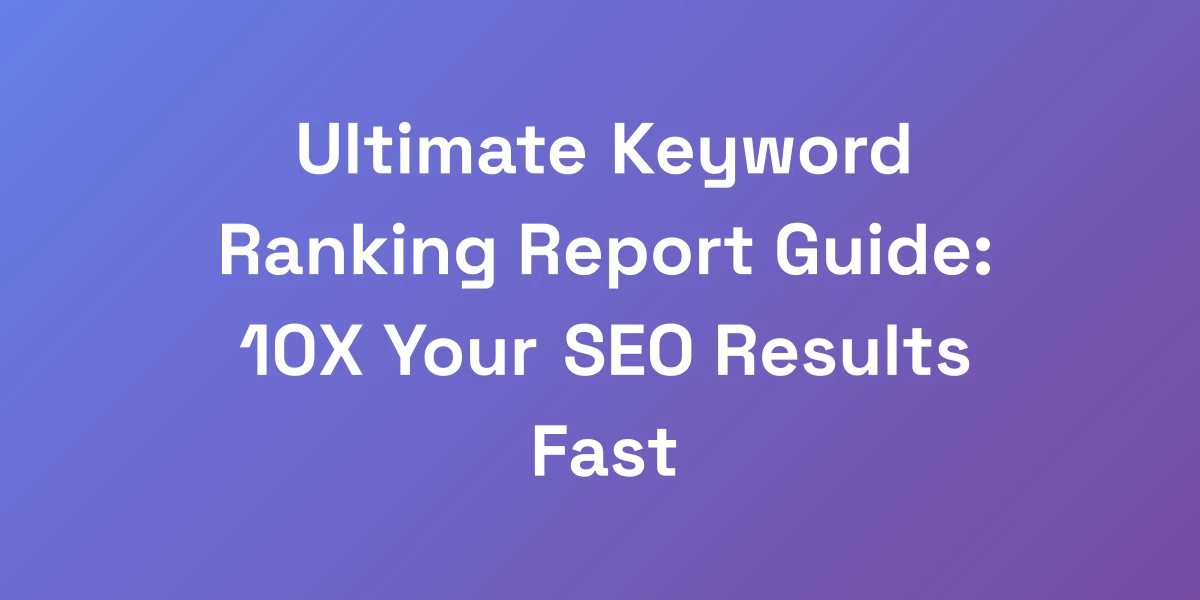
Ultimate Bulk Keyword Position Checker Guide: 10X Your SEO Results
Apr 2, 2025 | By [email protected]
Imagine this: you’ve invested countless hours optimizing your website, crafting killer content, and building backlinks. Yet, your efforts seem to be floating in the vast ocean of the internet, barely making a ripple. Frustrating, right?
We’ve all been there. The struggle to check your position in Google in the ever-shifting landscape of search engine results can feel like chasing shadows.
But here’s the kicker: if you can’t measure it, you can’t improve it. Without accurate keyword position tracking, your SEO efforts are essentially shot in the dark. The difference between those who thrive and those who merely survive in the SEO game often boils down to how effectively they monitor and manage their keyword positions at scale.
Let’s cut through the noise and dive deep into the world of bulk keyword position checkers. We’re about to unveil strategies and tools that will not just elevate your SEO game but potentially 10X your results. Ready to transform your approach? Let’s get started.
Why Most SEOs Fail at Keyword Position Tracking (And How to Fix It)
Let me hit you with some truth: 95% of SEOs are tracking their keywords wrong. They’re wasting hours manually checking positions, using unreliable tools, or worse— not tracking at all. Here’s the reality: if you can’t measure it, you can’t improve it. We’ve seen businesses transform their organic traffic by simply implementing the right bulk keyword tracking system. The difference between average and exceptional SEO results often comes down to how effectively you monitor your keyword positions at scale. Let’s break down why most people fail and how you can gain an unfair advantage.
Common Keyword Tracking Mistakes Killing Your SEO
First off, let’s talk about the mistakes that are silently sabotaging your SEO efforts:
- Manual Tracking: Relying on spreadsheets and manual checks not only consumes time but also introduces errors that can skew your data.
- Ignoring Long-Tail Keywords: Focusing solely on high-volume keywords neglects the potential of long-tail keywords, which often have higher conversion rates.
- One-size-fits-all Tools: Using generic rank trackers that don’t cater to your specific needs, such as multi-location tracking or device-specific rankings.
- Not Tracking Competitors: SEO isn’t a solo game. Failing to monitor your competitors’ keyword strategies leaves you blind to opportunities and threats.
- Overlooking Local and Mobile Rankings: With the rise of mobile search and localized queries, ignoring these aspects can significantly impact your visibility.
Avoiding these pitfalls is crucial. Let’s dive into the real cost of manual position checking next.
The Real Cost of Manual Position Checking
Think about this: how many hours have you spent manually checking keyword positions? Now, multiply that by the days, weeks, or even months. It adds up.
Manual tracking isn’t just time-consuming—it’s inefficient. Human error can lead to inaccurate data, which in turn can misguide your SEO strategies. Moreover, the sheer volume of keywords that successful websites monitor can easily reach into the thousands. How feasible is it to manage that manually?
Here’s a scenario: A mid-sized e-commerce site tracking 500 keywords manually could spend upwards of 10 hours a week just on tracking. That’s time that could be spent on optimizing content, building backlinks, or enhancing user experience. Not to mention, the risk of missing critical ranking changes that could affect your traffic and revenue.
According to SEO timing statistics, automating this process with a reliable bulk keyword position checker can save you time, reduce errors, and provide real-time insights that keep you ahead of the competition.
Why Traditional Rank Trackers Fall Short
Traditional rank trackers have their place, but they often fall short in today’s dynamic SEO environment. Here’s why:
- Limited Scalability: Many traditional tools can’t handle the volume of keywords large businesses track, leading to incomplete data.
- Insufficient Features: Basic rank trackers might not offer advanced features like multi-location tracking, device-specific rankings, or integration with other SEO tools.
- Data Delays: Slow data refresh rates mean you’re always playing catch-up, reacting to changes rather than proactively managing your SEO strategy.
- Lack of Customization: One-size-fits-all approaches don’t allow for the tailored tracking that specific industries or businesses might require.
These limitations can severely hamper your ability to effectively track and optimize your keyword positions. That’s why investing in a high-performance bulk keyword position checker is non-negotiable for serious SEOs.
The Scale Problem: Managing 1000+ Keywords
Managing a small set of keywords might be feasible manually, but what happens when you’re dealing with 1,000 or more keywords? The scale introduces several challenges:
- Time Consumption: As the number grows, so does the time required to track each keyword’s position.
- Data Management: Organizing and making sense of vast amounts of data becomes increasingly complex without the right tools.
- Consistency: Ensuring consistent tracking intervals and accurate data becomes nearly impossible manually.
A robust bulk keyword position checker can effortlessly handle large volumes of keywords, providing you with organized, accurate, and up-to-date data. This enables you to make informed decisions quickly and effectively.
Impact of Not Tracking Local and Mobile Rankings
With the surge in mobile usage and the importance of local search, failing to track local and mobile rankings can be detrimental. Here’s why:
- Mobile Dominance: More than half of all web traffic comes from mobile devices. Ignoring mobile rankings means missing out on a significant portion of potential traffic.
- Local Search Relevance: Local searches often have higher conversion rates as users are looking for nearby solutions. Neglecting this can limit your reach within important markets.
By incorporating local and mobile tracking into your SEO strategy, you ensure that you’re not just visible, but prominently visible where it matters most. Tools that offer multi-location and device-specific tracking can provide these critical insights.
Essential Features of a High-Performance Bulk Keyword Checker
After spending millions on marketing and analyzing countless SEO campaigns, we’ve identified the non-negotiable features that separate elite keyword tracking tools from the rest. Your bulk keyword position checker must be a weapon, not just a tool. The right system will give you instant insights across thousands of keywords, multiple locations, and different devices—all while saving you hours of work. Time is money, and the features we’re about to share will help you maximize both.
Real-Time Position Tracking Capabilities
In the fast-paced world of SEO, timing is everything. Real-time position tracking ensures that you’re always up-to-date with the latest keyword rankings. This feature allows you to:
- React Quickly: Identify and respond to ranking fluctuations as they happen.
- Monitor Competitors: Keep a close eye on your competitors’ movements and adjust your strategies accordingly.
- Measure Impact: Assess the immediate impact of your SEO efforts and campaigns.
For example, if you launch a new content piece, real-time tracking lets you see its effect on your keyword rankings almost instantly, allowing you to refine your approach on the fly.
Multi-Location and Device Support
Search results can vary significantly based on location and device. A high-performance bulk keyword checker should offer:
- Geographical Tracking: Monitor keyword rankings across different countries, states, or cities to tailor your SEO strategy to each market.
- Device-Specific Data: Understand how your keywords perform on mobile, desktop, and tablet devices to optimize your content for each platform.
Imagine running an international campaign. With multi-location tracking, you can see which regions are driving the most traffic and which ones need more attention, allowing you to allocate resources more effectively.
Data Accuracy and Refresh Rates
Accurate data is the backbone of any successful SEO strategy. A top-tier keyword position checker offers:
- High Accuracy: Reliable data collection methods to minimize errors and provide trustworthy insights.
- Frequent Updates: Regular data refresh rates to ensure you have the most current information at your fingertips.
For instance, tools like bulk rank checkers can track up to 100,000 keywords in just an hour, providing timely data that keeps you informed and agile in your SEO strategies.
API Integration and Export Options
Seamless integration with other tools and platforms is essential for a streamlined workflow. Look for features like:
- API Access: Connect your keyword tracking data with other SEO tools, dashboards, and reporting systems for a unified view.
- Export Options: Easily export data to various formats (CSV, Excel, etc.) for further analysis or sharing with your team.
API integration allows you to automate data flows, reducing manual work and ensuring that your SEO data is always up-to-date across all platforms you use.
Advanced Filtering and Segmentation
With thousands of keywords to track, advanced filtering and segmentation become crucial. Features to look for include:
- Custom Filters: Segment keywords based on various criteria such as search volume, competition level, or specific campaigns.
- Dynamic Segmentation: Automatically group keywords into meaningful categories for easier analysis and reporting.
This functionality allows you to focus on the most impactful keywords, uncover trends, and identify areas for optimization without getting bogged down by irrelevant data.
Historical Data and Trend Analysis
Understanding past performance is key to predicting future trends. A robust bulk keyword checker should provide:
- Historical Data: Access to keyword ranking history to identify trends, seasonality, and long-term performance.
- Trend Analysis: Tools to analyze changes over time, helping you understand what strategies work and where adjustments are needed.
For example, by examining historical data, you can identify which keywords have consistently performed well and which ones need a new strategy to regain lost ground.
Implementing a Scalable Keyword Tracking System
Here’s what nobody tells you about scaling your keyword tracking: it’s not just about the tool – it’s about the system. We’ve built and scaled multiple 8-figure businesses, and the secret sauce is always in the implementation. You need a process that scales without breaking. Your keyword tracking system should work like a well-oiled machine, automatically collecting data and flagging opportunities while you focus on strategy. Let us show you exactly how to set this up.
Setting Up Your First Bulk Track
Starting with bulk keyword tracking can be overwhelming, but it doesn’t have to be. Here’s a step-by-step approach:
- Define Your Goals: Determine what you want to achieve with your keyword tracking—be it increasing organic traffic, improving conversion rates, or outperforming competitors.
- Choose the Right Tool: Select a bulk keyword position checker that aligns with your needs and offers the essential features discussed earlier.
- Import Your Keywords: Gather all your target keywords from tools like Ahrefs, Moz, or Semrush and import them into your chosen tracking tool.
- Set Tracking Parameters: Configure settings for locations, devices, and search engines to ensure comprehensive tracking.
Imagine setting up your bulk tracking system as building the foundation of a skyscraper. Get it right from the start, and everything else will stand tall and strong.
Organizing Keywords for Maximum Insight
Organization is key to manageable and insightful tracking. Here’s how to structure your keywords:
- Create Categories: Group keywords into logical categories based on themes, product lines, or target audiences.
- Prioritize High-Impact Keywords: Focus on keywords that drive the most traffic or have the highest conversion potential.
- Use Tagging Systems: Implement tags for easy filtering and segmentation, allowing you to quickly drill down into specific areas of interest.
By organizing your keywords effectively, you ensure that you can extract meaningful insights and make data-driven decisions without getting lost in the chaos of unmanaged data.
Creating Custom Tracking Schedules
Tracking frequency can greatly impact your SEO strategy. Here’s how to tailor your tracking schedules:
- Set Regular Intervals: Determine how often you need to track your keywords—daily, weekly, or monthly—based on your goals and the volume of keywords.
- Adjust Based on Performance: Increase tracking frequency for high-priority keywords or those underperforming to ensure timely interventions.
- Automate Reporting: Use automation features to receive regular reports, freeing up your time to focus on strategy rather than manual data collection.
Think of tracking schedules as your SEO pulse check. Regular monitoring keeps your finger on the pulse, allowing you to respond promptly to any changes.
Setting Up Automated Alerts
Automated alerts are your early warning system in the SEO battlefield. Here’s how to implement them effectively:
- Define Alert Criteria: Set up alerts for significant ranking drops, gains, or any anomalies that require immediate attention.
- Customize Notifications: Choose how you want to receive alerts—email, SMS, or through your dashboard—to ensure you don’t miss critical updates.
- Respond Quickly: Have a plan in place to address alerts swiftly, whether it’s adjusting your content strategy, fixing technical issues, or capitalizing on ranking gains.
With automated alerts, you’re no longer in the dark. You’re proactively managing your SEO efforts, ready to tackle challenges as soon as they arise.
Integration with Your SEO Workflow
A tracking system should seamlessly fit into your existing SEO workflow. Here’s how to ensure smooth integration:
- Connect with Other Tools: Integrate your keyword tracker with other SEO tools like Google Analytics, Google Search Console, and your CMS for a unified workflow.
- Automate Data Sharing: Use API integrations to automate the flow of data between tools, reducing manual work and increasing efficiency.
- Collaborate with Your Team: Ensure that your team has access to the tracking data and understands how to use it to inform their strategies.
Integration transforms your keyword tracking system from a standalone tool into a central hub that drives your entire SEO strategy forward.
Scaling Beyond 10,000 Keywords
Once you’ve mastered tracking hundreds of keywords, scaling to 10,000+ brings new opportunities and challenges:
- Leverage Automation: Advanced bulk keyword trackers are built to handle large volumes effortlessly, ensuring data remains accurate and manageable.
- Segment Strategically: Break down your keyword lists into smaller, manageable segments to focus on specific areas without being overwhelmed.
- Maintain Data Quality: Regularly audit your keyword lists to remove duplicates, irrelevant terms, and ensure you’re tracking the most valuable keywords.
Scaling up means exponentially increasing your potential for insights and growth, provided you have the right system in place to manage the complexity. For startups looking to scale efficiently, exploring SEO for startups can provide tailored strategies to handle such growth.
Advanced Strategies for Keyword Position Analysis
Most people look at keyword rankings and see numbers. We see money on the table. The real power of bulk keyword tracking comes from how you analyze and act on the data. We’re going to share the exact framework we use to turn ranking data into actionable insights that drive revenue. This isn’t theory—these are battle-tested strategies that have generated millions in organic traffic value.
Identifying Quick-Win Opportunities
Quick-wins are like low-hanging fruit in your SEO orchard. They require minimal effort but yield significant results. Here’s how to find them:
- Look for Small Drops: Identify keywords that have slipped just a few ranks. These are easier to recover and can quickly boost your visibility.
- Analyze Search Intent: Ensure your content aligns with the search intent. If it doesn’t, tweak it to better match what users are looking for.
- Optimize Meta Tags: Often, small tweaks to your meta titles and descriptions can improve click-through rates and boost rankings.
For example, a minor adjustment in a meta description to more accurately reflect the content can lead to higher click-through rates, translating into better rankings and more traffic.
Competitor Gap Analysis
Understanding where your competitors are excelling can reveal opportunities for your own strategy. Here’s how to conduct a competitor gap analysis:
- Identify Top Competitors: Determine who your main competitors are for your target keywords.
- Analyze Their Rankings: Use your bulk keyword tracker to see where they outrank you.
- Evaluate Their Content: Examine their content strategies. What topics are they covering that you’re not?
- Find Link Opportunities: Identify backlink sources that your competitors are leveraging and explore how you can tap into similar or better opportunities.
By bridging these gaps, you can enhance your own SEO efforts and potentially surpass your competitors in key areas.
SERP Feature Optimization
Search Engine Results Pages (SERPs) are not just about organic listings anymore. They include various features like snippets, videos, and local packs. Optimizing for these features can significantly boost your visibility:
- Featured Snippets: Structure your content to answer specific questions concisely, increasing the chances of being featured.
- Rich Media Integration: Incorporate images, videos, and infographics to make your content more engaging and likely to be featured in multimedia SERP features.
- Local Pack Optimization: Ensure your business information is accurate and optimized for local searches, enhancing your chances of appearing in local packs.
Imagine your content being highlighted right at the top of the SERP in a featured snippet. It not only boosts your visibility but also establishes your authority on the topic.
Content Performance Correlation
Connecting keyword rankings to content performance is crucial for a data-driven SEO strategy. Here’s how to correlate the two effectively:
- Track Engagement Metrics: Monitor metrics like bounce rate, time on page, and click-through rates to understand how your content is performing.
- Link Performance: Analyze which backlinks are driving the most traffic and how they correlate with keyword rankings.
- Content Updates: Regularly update and optimize high-performing content to maintain and improve its rankings.
For instance, if a particular blog post consistently ranks high and attracts significant traffic, enhancing it further with updated information or additional keywords can amplify its performance even more.
ROI-Based Ranking Prioritization
Not all keywords are created equal. Focusing on those that offer the highest return on investment (ROI) ensures your efforts are impactful:
- Analyze Conversion Rates: Identify which keywords drive the most conversions and prioritize tracking and optimizing those.
- Evaluate Profit Margins: Focus on keywords that bring in traffic from high-margin products or services.
- Assess Competition: Balance high-value keywords with a realistic understanding of the competition to target those where you can realistically rank higher.
Targeting high-ROI keywords means that your SEO efforts are directly contributing to your bottom line, making every optimization decision a step towards greater profitability.
Market Share Analysis
Understanding your market share in the SERPs provides insight into your competitive positioning:
- Identify Key Players: Determine who else is ranking for your target keywords and what share of the market you each hold.
- Measure Growth: Track how your market share evolves over time, identifying trends and shifts in the competitive landscape.
- Strategize Accordingly: Use this analysis to inform your strategic decisions, such as where to invest more resources or where to pull back.
By regularly analyzing market share, you can ensure you’re not just competing, but leading in your chosen niches.
Future-Proofing Your Keyword Tracking Strategy
The SEO landscape is constantly evolving, and your keyword tracking strategy needs to evolve with it. What worked yesterday won’t necessarily work tomorrow. We’ve seen too many businesses get left behind because they failed to adapt. Here’s how to build a future-proof keyword tracking system that will keep you ahead of the curve and your competition scrambling to catch up.
Emerging Trends in Search Analytics
Staying abreast of the latest trends in search analytics ensures your strategies remain effective:
- AI and Machine Learning: Leveraging search engine optimization automation to predict trends and optimize keyword strategies dynamically.
- Voice Search Optimization: Adapting to the rise of voice search by optimizing for conversational queries and long-tail keywords.
- Visual Search: Incorporating image and video optimization to capture traffic from visual search queries.
By anticipating and integrating these trends, you can maintain a competitive edge and capitalize on new opportunities as they arise.
AI and Machine Learning Integration
AI and machine learning are revolutionizing SEO by enabling more sophisticated data analysis and predictive capabilities. Here’s how to integrate them:
- Predictive Analytics: Use AI to forecast keyword performance and identify emerging trends before your competitors.
- Automated Insights: Leverage machine learning algorithms to automatically generate insights and recommendations based on your tracking data.
- Personalization: Implement AI-driven personalization to tailor your SEO strategies to different audience segments.
AI can take your keyword tracking from reactive to proactive, ensuring you’re always a step ahead in your SEO game.
Voice Search Tracking Capabilities
With voice search on the rise, optimizing for it is no longer optional. Here’s how to enhance your tracking capabilities:
- Long-Tail Keywords: Focus on longer, conversational queries that are common in voice searches.
- Question-Based Content: Create content that answers specific questions, increasing the likelihood of being featured in voice search results.
- Local Voice Search Optimization: Ensure your local SEO is robust, as many voice searches are location-based.
By tracking and optimizing for voice search, you can tap into a growing segment of search traffic that values convenience and immediacy.
Privacy-First Tracking Methods
As privacy regulations tighten, adopting privacy-first tracking methods is essential to stay compliant and maintain user trust:
- Data Anonymization: Ensure that all collected data is anonymized to protect user privacy.
- Compliance with Regulations: Adhere to laws like GDPR and CCPA by implementing strict data handling and storage practices.
- Transparent Data Practices: Clearly communicate your data collection and usage practices to your users.
Implementing privacy-first methods not only ensures compliance but also builds trust with your audience, which is invaluable in today’s digital landscape.
Cross-Platform Ranking Analysis
Users access content across various devices and platforms, making cross-platform ranking analysis crucial:
- Multi-Device Tracking: Monitor how your keywords perform on desktops, tablets, and mobile devices separately.
- Platform-Specific Optimization: Tailor your SEO efforts based on the platform-specific performance data.
- Unified Reporting: Consolidate data from all platforms to get a comprehensive view of your SEO performance.
This holistic approach ensures that you’re capturing and optimizing for every possible user interaction point, maximizing your SEO effectiveness.
Predictive Ranking Intelligence
Predictive ranking intelligence utilizes data to forecast future keyword performance, allowing you to stay ahead:
- Trend Identification: Use historical data to identify and capitalize on trending keywords before they peak.
- Performance Forecasting: Predict how changes in your SEO strategy might impact keyword rankings in the future.
- Adaptive Strategies: Adjust your SEO tactics based on predictive insights, ensuring your strategies remain effective over time.
By incorporating predictive intelligence, you can make data-driven decisions that not only respond to current trends but also anticipate future shifts in the SEO landscape.
Conclusion
We’ve journeyed through the intricate world of bulk keyword position tracking, uncovering why most SEOs falter and how you can rise above the rest. We delved into the essential features that make a keyword tracker a true game-changer and explored scalable strategies to manage thousands of keywords without breaking a sweat.
But we didn’t stop there. We shared advanced strategies that transform raw data into revenue-driving insights and future-proofed your SEO approach to stay ahead of evolving trends. For more insights on top SEO stories of 2024, business blogging, and SEO in 2024 trends, the key takeaway? A robust, scalable, and intelligent bulk keyword position checker isn’t just a tool—it’s the backbone of a successful SEO strategy.
Ready to supercharge your SEO efforts and see tangible results? It’s time to implement these strategies and invest in a high-performance bulk keyword position checker. Start tracking smarter, not harder, and watch your organic traffic—and revenue—soar. Additionally, if you’re an aspiring professional, understanding SEO freelancing can open new avenues for growth and expertise.
What’s your biggest SEO challenge right now? Drop a comment below and let’s tackle it together!








